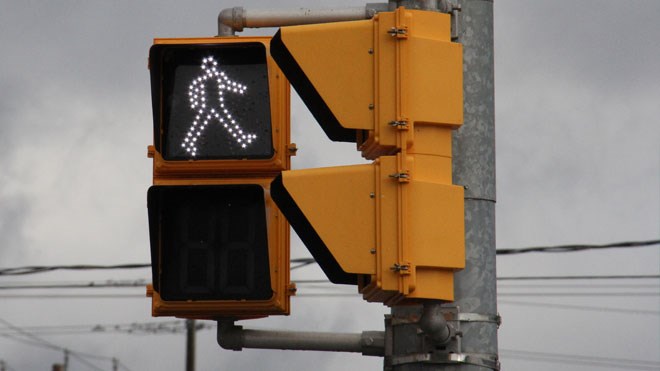Orillia now has a Pedestrian Charter.
Last February, Orillia’s Cheryl Lousley made a pitch to the Active Transportation Committee regarding the Region of Waterloo’s Pedestrian Charter. The idea was to create a similar charter for the Sunshine City.
In the fall, a working group got to work. They reviewed existing charters from several Ontario municipalities and decided that the City of Toronto’s version, developed in 2002 following “fulsome research and consultation”, would form the foundation for Orillia’s manifesto.
The working group hosted an information and discussion forum in February of 2018 with key community stakeholders. The forum was attended by representatives from seven community organizations/institutions, four civic committees/boards and four members of city council.
In March 2018, the proposed draft Pedestrian Charter was also published in local newspapers and on the city’s website with a request for general feedback. Comments were received from 27 citizens.
Staff noted most “appear to be supportive.” Many appreciate the trail system and feel it is well maintained; some said they wished sidewalks were kept to the same standard.
Sidewalk snow-clearing was the biggest issue identified by almost all citizens. “This presents winter-walking challenges especially for seniors, those with mobility restrictions and accessibility needs and those with young kids and strollers,” said a report from staff.
In addition, uneven, crumbling sidewalks and curbs, narrow sidewalks and lack of sidewalks were also raised as concerns in addition to lack of safe crosswalks at key locations.
Others suggested reducing residential speed limits, better educating drivers and enforcing traffic laws to make it safer for pedestrians crossing streets.
The idea of a pedestrian charter was endorsed by the Orillia Public Library Board, Simcoe Muskoka District Health Unit, Orillia/Ramara trustee for Simcoe County District School Board Jodi Lloyd, Information Orillia and Orillia Soldiers’ Memorial Hospital.
The plan, endorsed in principle at Monday night’s council committee meeting, is not a legal document. Rather it is “a public statement of philosophy held by the city with regards to active transportation.”
In fact, there was some question as to how the new charter might be used. Coun. Tim Lauer asked staff if the charter, for example, could give the city ammunition when a developer makes a pitch to council.
He said, for example, there is a plan that calls for a commercial area within the West Ridge residential development. Lauer said he has heard rumblings the developer may come to council asking to remove that commercial hub and construct more housing.
Ian Sugden, the city's director of planning, said the idea was to create a "walkable" community where residents could easily walk to commercial enterprises within the neighbourhood.
While the new pedestrian charter would be "another layer" of documentation staff could use, it's not "legislatively enforceable." Despite that, staff could cite the charter in its future recommendations to council.
In the end, council was effusive in its praise of the new charter, which was adopted in principle and will be circulated for staff input.
Orillia’s Pedestrian Charter states:
Walking is the most ancient and universal form of travel. It is also an important form of exercise and recreation. Every personal trip involves walking, alone or in combination with taking public transit, driving or cycling.
A pedestrian is a person moving from place to place, either by foot or by using an assistive mobility device. Pedestrians include residents and visitors to the city of all ages and abilities, from babies in strollers to seniors in their nineties.
In order to travel safely, conveniently, directly and comfortably, they require an urban environment and infrastructure designed to meet their travel needs. An urban environment that encourages and facilitates walking supports community health, vitality and safety.
It will increase use of public transit; decrease car dependence; reduce conflict between vehicles and pedestrians; lead to cleaner air; green public space; and support green tourism. Such an environment creates opportunities for the informal social interaction that is one of the main attributes of a vibrant, livable city.
To create an urban environment in all parts of the city that encourages and supports walking, the City of Orillia:
- upholds the right of pedestrians of all ages and abilities to safe, convenient, direct and comfortable walking conditions;
- provides a walking environment within the public right-of-way and in public parks that encourages people to walk for purpose, exercise and recreation in all seasons;
- supports and encourages the planning, design and development of a walking environment in public and private spaces (both exterior and interior) that meets the mobility and accessibility needs of pedestrians;
- provides and maintains infrastructure that gives pedestrians safe and convenient passage while walking along and crossing streets;
- ensures that residents’ access to basic community amenities and services does not depend on car ownership or public transit use;
- sets policies that reduce conflict between pedestrians and other users of the public right-of-way;
- creates walkable communities by giving high planning priority to compact, human-scale and mixed land use;
- encourages research and education on the social, economic, environmental and health benefits of walking as a form of travel, exercise and recreation;
- promotes laws and regulations that respect pedestrians’ particular needs;
- advocates for improving the provincial and federal regulatory and funding frameworks that affect the City’s ability to improve the pedestrian environment; and
- works with individual citizens, community groups and agencies, businesses and other levels of government to achieve these goals.
Decisions made by council committee must be ratified at Monday night’s city council meeting.
